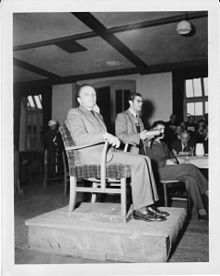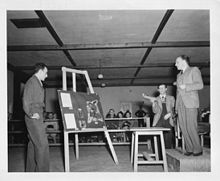Kurt custom

Kurt Sitte (born December 1, 1910 in Reichenberg , Bohemia , Austria-Hungary ; † June 20, 1993 in Freiburg im Breisgau ) was a Czech-German nuclear physicist of Sudeten German origin, a former political prisoner in Buchenwald concentration camp and, after liberation from National Socialism, as a university lecturer active. He was "the first space spy in world history and the accused in the first espionage trial in the history of Israel".
Origin, studies and anti-fascist resistance
Kurt Sitte was the son of the eponymous senior teacher and painter Kurt Sitte and his wife Gisela, née Shift. After graduating from high school , he studied mathematics and physics at the German University in Prague , where he received his doctorate in 1932. rer. nat. received his doctorate . He completed his habilitation in physics in Prague in 1935 and then worked there as a private lecturer . Sitte presided over the democratic discussion group Die Tat in Reichenberg and was active in the anti-fascist Sudeten German resistance . During the Sudeten crisis in the run-up to the Munich Agreement , on September 18, 1938, he was one of the co-founders of the “National Council of all Sudeten Germans willing to make peace”.
Prisoner in Buchenwald concentration camp
After the annexation of the remaining Czech state by the National Socialist German Reich in March 1939, Sitte was initially imprisoned in Prague and later briefly sent to the Dachau concentration camp as a political prisoner . At the end of September 1939 he was transferred to the Buchenwald concentration camp . Sitte worked in the camp's SS pathology department from spring 1942 and became the deputy of the local Kapos Gustav Wegerer . Both of them gave interested fellow inmates courses on medical and biological topics, as their fellow inmate Eugen Kogon reported. The concentration camp doctor Waldemar Hoven had his dissertation with the title "Attempts to treat pulmonary tuberculosis by inhaling carbon colloid" written by Wegerer und Sitte in Buchenwald . Sitte's name was on a list of 46 named political prisoners whom the SS wanted to execute shortly before the camp was liberated. However, like almost everyone on the list, he went into hiding in the camp. On April 11, 1945 Sitte experienced the liberation of Buchenwald concentration camp by members of the US Army . His girlfriend, a Jewish woman from Prague and his future wife, also survived the concentration camp imprisonment.
Post-war period - witness in the main Buchenwald trial and university professor
After the liberation from National Socialism , he was a research fellow from 1946 at the universities of Edinburgh and Manchester .
In April 1947 Sitte testified as a witness for the prosecution in the main Buchenwald trial . In this context, he identified prepared human skin from the camp. According to him, the skin preparations were made in Buchenwald and their use was decided elsewhere. His statements incriminated the so-called "Kommandeuse von Buchenwald" Ilse Koch , although she was not proven to be guilty of any concrete guilt - neither because of any possession of corresponding objects nor because of orders to have tattooed prisoners killed because of their skin. Koch's life imprisonment was reduced to four years' imprisonment in 1948 by a military court on appeal. a. as the judgment was based too much on hearsay. In this context, Sitte was questioned by members of a commission of inquiry consisting of American senators about a shrunken head from Buchenwald. Custom confirmed that it was a human head. He stated that this was one of two from the SS-Pathology collection and that he had seen the victims alive. According to him, these two shrunken heads came from two Polish concentration camp prisoners who tried unsuccessfully to flee Buchenwald in late 1939 or 1940. Both had been arrested again, had been beaten in front of the assembled prisoners in the camp and were later hanged in the camp's crematorium to the exclusion of the prisoners.
Sitte moved to the United States in 1948 , where he was a professor of physics at Syracuse University . There he began to research nuclear physics and cosmic rays . He became a member of the New York Academy of Sciences in 1953 . Because of his friendship with Czechoslovak communists, whom he knew from Buchenwald and visited during his travels to the Eastern Bloc , he was under observation by the FBI . Since the FBI recommended in 1953 not to renew Sitte's residence permit, he left the United States. In 1953/54 he took over a visiting professorship at the University of São Paulo . In the US, custom was eventually classified as a security risk. During a business trip to Rome during a stopover in New York, he was denied an overnight stay in a hotel and he had to fly back to Brazil immediately - monitored by the FBI.
Condemned as a space spy in Israel
In October 1954 Sitte found a job as a sought-after expert in nuclear physics in Haifa at the technical center and founded the nuclear physics department there, which he took over as head. In 1955 he became president of the Israeli Physical Society. Through his offices and functions, he was also aware of research projects on nuclear physics at the Weizmann Institute of Science and the Hebrew University of Jerusalem . Sitte was entrusted with the processing of foreign orders, including space projects for the United States Air Force (USAF). In 1959 he became deputy head of the research institute of the Technikum, which was dominated by American, British and Canadian supervisory boards, and was therefore an expert on the practical evaluation of space research carried out there. Because of its exposed position, Sitte was under surveillance by the Israeli secret service. He made himself suspicious not only because of his trips to communist Czechoslovakia and two stays in the Soviet Union, but from the beginning of 1960 also because of multiple conspiratorial meetings with a Czech diplomat in changing cafes. In June 1960, Sitte asked his staff to write reports on their research. Finally, on June 15, 1960, Sitte was arrested at his villa in Haifa and his property was searched. His arrest was based on an accusation of divulging state secrets to foreign powers. Sitte admitted his contacts to the Czech diplomat during interrogations. He stated that he had thereby protected his family members living there and that these conversations only served to exchange information between scientists. According to Israeli intelligence, Sitte feared that his research into cosmic rays as a potential source of energy could lead to a confrontation between the two world powers, the USA and the Soviet Union . To prevent this, he disclosed information about it to the Soviet Union. Before the District Court in Haifa began on November 5, 1960 in camera, the secret trial against custom for offenses against the Israeli State Security Act of 1957. On February 7, 1961, Sitte was sentenced to five years imprisonment for passing on secret information to a foreign power , the verdict was upheld in an appeal hearing. He was released early from prison on March 26, 1963 for good conduct.
Professor in Freiburg
Sitte, who had German citizenship, moved to the Federal Republic of Germany with his second wife. Since 1963 he was married to Judith Sitte-Amon, nee Krymokowski, for the second time. The couple had a son. From 1963 to 1971 he was visiting professor and then honorary professor at the University of Freiburg im Breisgau . In addition, from 1964 to 1967 he worked at the Max Planck Institute for Nuclear Physics in Heidelberg . From 1970 to 1983 he was a member of the scientific council of the Laboratorio di Cosmo-Geofisica del CNR in Turin , where he was full professor of physics from 1966 to 1970. He was the author of numerous specialist publications.
literature
- Who is who? 32nd edition, Verlag Schmidt-Römhild, Lübeck 1993, ISBN 3-7950-2013-1 , p. 1292
- Olival Freire Junior: The Quantum Dissidents. Rebuilding the Foundations of Quantum Mechanics (1950-1990) , Springer-Verlag, Berlin / Heidelberg 2015, ISBN 978-3-662-44661-4 , p. 179
- Custom Trial - Spy In Space . In: Der Spiegel , 3/1961 edition of January 11, 1961, pp. 44-45, online
Web links
- Ami Dor-On: Kurt Sitte - A Russian “Sleeper Agent” in Israel on i-HLS.com, October 20, 2013
Individual evidence
- ↑ Customs Trial - Spy in Space . In: Der Spiegel , issue 3/1961 of January 11, 1961, p. 44
- ↑ a b c d e Who is who? 32nd edition, Verlag Schmidt-Römhild, Lübeck 1993, ISBN 3-7950-2013-1 , p. 1292
- ↑ Detlef Brandes : Die Sudetendeutschen in the crisis year 1938. R. Oldenbourg, Munich 2008, ISBN 3-486-58742-0 , p. 285
- ↑ a b c d e Olival Freire Junior: The Quantum Dissidents. Rebuilding the Foundations of Quantum Mechanics (1950-1990) , Springer-Verlag, Berlin / Heidelberg 2015, ISBN 978-3-662-44661-4 , p. 179
- ↑ Ronald Hirte / Harry Stein: The relationship between the University of Jena and the Buchenwald concentration camp . In: Uwe Hoßfeld , Jürgen John , Oliver Lehmuth and Rüdiger Stutz (eds.): "Combative Science". Studies at the University of Jena under National Socialism . Cologne 2003, ISBN 978-3-412-04102-1 , p. 386
- ↑ Ernst Klee : Auschwitz, Nazi medicine and its victims. 3. Edition. S. Fischer Verlag, Frankfurt am Main, 1997, ISBN 3-596-14906-1 , p. 41f.
- ↑ David A. Hackett: The Buchenwald Report: Report on the Buchenwald concentration camp near Weimar , CH Beck, Munich 1996, ISBN 3-406-41168-1 , p. 131f. and 366
- ↑ a b c d e f Ami Dor-On: Kurt Sitte - A Russian “Sleeper Agent” in Israel on i-HLS.com, October 20, 2013
- ↑ Arthur Lee Smith Jr .: The case of Ilse Koch - Die Hexe von Buchenwald , Böhlau Verlag, Cologne / Weimar / Vienna, 3rd edition 1995, ISBN 978-3-412-10693-5 , p. 128
- ↑ Lawrence Douglas: The Shrunken Head of Buchenwald: Icons of Atrocity at Nuremberg . In: Barbie Zelizer: Visual Culture and the Holocaust , Rutgers, The State University, 2001, ISBN 0-8135-2892-5 , p. 298
- ↑ a b Customs Trial - Spy in Space . In: Der Spiegel , issue 3/1961 of January 11, 1961, p. 44f.
- ↑ Kürschner's German Scholars Calendar , Volume 3, Walter de Gruyter, 1992, p. 3526
| personal data | |
|---|---|
| SURNAME | Custom, Kurt |
| BRIEF DESCRIPTION | Czech-German physicist, concentration camp prisoner and spy |
| DATE OF BIRTH | December 1, 1910 |
| PLACE OF BIRTH | Reichenberg , Bohemia , Austria-Hungary |
| DATE OF DEATH | June 20, 1993 |
| Place of death | Freiburg in Breisgau |
